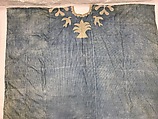Robe (boubou)
Not on view
A factory woven cotton damask patterned boubou with embroidery. The boubou is dyed in light blue and is extensively adorned with white embroidery around the collar and upper torso. Figurative patterns representing birds, palm trees and floral motifs are embroidered on both outer faces of the garment. The embroidery is particularly skillfully rendered.
This boubou (corruption of Wolof mbubb) is a distinctive example of the traditional hand-woven and -embroidered, over-the-head garment worn by elites across West Africa. These robes are always worn over other clothing and generally fall to the lower leg. Of particular interest in this example are the refined embroideries that form distinctive figurative motifs. The embroideries are so tightly stitched that they give the impression of appliqué. While we don't know precisely where in West Africa the boubou was collected, the visual reference to applique and the figurative patterns of birds and palm tree suggest that it might have come from present-day Ghana or Benin that are known for their distinctive use of the appliqué technique and figurative motifs.
This image cannot be enlarged, viewed at full screen, or downloaded.

